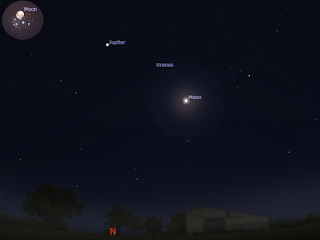Friday, October 27, 2023
Occultation Pleiades 30-31 October 2023.
| Morning
sky on Tuesday, October 31 as seen from Adelaide at 00:40 ACDST, (click
to embiggen). The moon is just about to cover the star Merope in the
Pleiades. The inset is the binocular view of the moon at this time (click to embiggen). | Morning sky on Tuesday, October 31 as seen from Melbourne at 01:00 AEDST, (click to embiggen). The moon is just about to cover the star Merope in the Pleiades. The inset is the binocular view of the moon at this time (click to embiggen). | Evening sky on Monday, October 30 as seen from Perth at 23:00 AWST, (click to embiggen). The moon is just about to cover the star Atlas in the Pleiades. The inset is the binocular view of the moon at this time (click to embiggen). |
| Merope DB | Merope RD | Alcyone DB | Alcyone RD | |
| Adelaide ACDST | 00:43 | 1:15 | 1:33 | 1:57 |
| Brisbane AEST | 00:30 | 1:27 | 1:24 | 2:11 |
| Canberra AEDST | 1:13 | 2:19 | 2:03 | 3:04 |
| Darwin ACST | - | - | - | - |
| Hobart AEDST | 1:05 | 2:15 | 1:52 | 2:59 |
| Melbourne AEDST | 1:07 | 2:09 | 1:55 | 2:53 |
| Perth AWST (30th) | 23:10* | 23:44* | - | - |
| Sydney AEDST | 1:17 | 2:24 | 2:07 | 3:09 |
DB - disappear bright limb, RD - reappear dark limb.
* In Perth the Moon misses Merope and Alcyone, but passes over the bight star Atlas instead on the late evening of the 30th.
It’s best to set up around 30 minutes before the occultation so you can get oriented in the sky and don’t miss the beginning while fussing with equipment.
Cloud cover predictions can be found at SkippySky.
Here is the near-real time satellite view of the clouds (day and night) http://satview.bom.gov.au/
Labels: binoculars, Moon, Occultation, Pleiades, telescope






 Click to read about or order
Click to read about or order Click to read about or order
Click to read about or order Click to read about or order
Click to read about or order Click to read about or order
Click to read about or order




